In our earlier studies, we learned how to calculate the area of basic plane figures like squares, rectangles, and triangles using standard formulas. However, when the height of a triangle is not known, we cannot directly apply the usual area formula for triangles.
In Class 9 Math Chapter 12 Heron Formula, we learn a special method to find the area of a triangle when all three sides are known but the height is not given. This method is known as Heron’s Formula, named after the ancient Greek mathematician Hero (or Heron) of Alexandria.
Heron’s Formula is not only useful for triangles but can also be extended to find the area of certain types of quadrilaterals. This chapter includes practical problems based on Heron’s Formula and shows how it can be applied to real-life situations, such as calculating the area of triangular plots, walls, and more.
Find accurate and easy Class 9 Math Chapter 12 Heron Formula. These solutions offer step-by-step answers based on the latest NCERT syllabus to help students understand the application of Heron’s Formula in finding areas of triangles.
Question 1.
A traffic signal board, indicating ‘SCHOOL AHEAD’, is an equilateral triangle with side a. Find the area of the signal board, using Heron’s formula. If its perimeter is 180 cm, what will be the area of the signal board?
Solution:
For a triangle with sides a, b, and c, Heron’s formula is:
Area = √[s(s – a)(s – b)(s – c)],
where s = (a + b + c) / 2 is the semi-perimeter.
Since the triangle is equilateral, all sides are equal:
a = b = c
So,
s = (a + a + a) / 2 = (3a) / 2
Now applying Heron’s formula:
Area = √[s(s – a)(s – a)(s – a)]
= √[(3a/2) × (a/2) × (a/2) × (a/2)]
= √[(3a⁴) / 16]
= (a² / 4) × √3
Therefore, the area of the equilateral triangle is:
Area = (a² / 4) × √3 square units
Now, if the perimeter of the signal board is 180 cm, then:
Perimeter = 3a = 180
⇒ a = 60 cm
Substituting this value in the area formula:
Area = (60² / 4) × √3
= (3600 / 4) × √3
= 900 × √3
≈ 900 × 1.732
≈ 1558.8 cm²
Final Answer:
The area of the signal board is 900√3 cm² or approximately 1558.8 cm².
Question 2.
The triangular side walls of a flyover have been used for advertisements. The sides of the walls are 122 m, 22 m and 120 m (see figure). The advertisements yield an earning of ₹5000 per m² per year. A company hired one of its walls for 3 months. How much rent did it pay?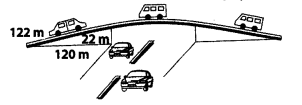
Solution:
Given sides of the triangle:
a = 122 m, b = 22 m, c = 120 m
First, find the semi-perimeter (s):
s = (a + b + c) / 2
= (122 + 22 + 120) / 2
= 264 / 2
= 132 m
Now use Heron’s formula:
Area = √[s(s – a)(s – b)(s – c)]
Substitute the values:
Area = √[132 × (132 – 122) × (132 – 22) × (132 – 120)]
= √[132 × 10 × 110 × 12]
= √[1742400]
≈ 1320 m²
The rate is ₹5000 per m² per year, so total yearly rent:
1320 × 5000 = ₹66,00,000
Since 3 months is 1/4 of a year, the rent for 3 months is:
(1/4) × ₹66,00,000 = ₹16,50,000
Question 3.
There is a slide in a park. One of its side Company hired one of its walls for 3 months.walls has been painted in some colour with a message “KEEP THE PARK GREEN AND CLEAN” (see figure). If the sides of the wall are 15 m, 11 m and 6m, find the area painted in colour.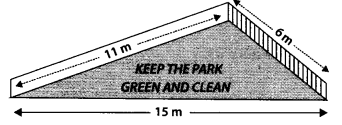
Solution:
Step 1: Use Heron’s formula
Given sides of the triangle:
a = 15 m, b = 11 m, c = 6 m
First, calculate the semi-perimeter (s):
s = (a + b + c) / 2
= (15 + 11 + 6) / 2
= 32 / 2
= 16 m
Now apply Heron’s formula:
Area = √[s(s – a)(s – b)(s – c)]
Substitute the values:
Area = √[16 × (16 – 15) × (16 – 11) × (16 – 6)]
= √[16 × 1 × 5 × 10]
= √[800]
≈ 28.28 m²
Question 4.
Find the area of a triangle two sides of which are 18 cm and 10 cm and the perimeter is 42 cm.
Solution:
Step 1: Find the third side
Let the third side be x.
Since the perimeter is 42 cm:
18 + 10 + x = 42
⇒ x = 42 – 28 = 14 cm
So, the sides of the triangle are:
a = 18 cm, b = 10 cm, c = 14 cm
First, find the semi-perimeter (s):
s = (a + b + c) / 2
= (18 + 10 + 14) / 2
= 42 / 2
= 21 cm
Now apply Heron’s formula:
Area = √[s(s – a)(s – b)(s – c)]
Substitute the values:
Area = √[21 × (21 – 18) × (21 – 10) × (21 – 14)]
= √[21 × 3 × 11 × 7]
= √[4851]
≈ 69.64 cm²
Question 5.
Sides of a triangle are in the ratio of 12 : 17 : 25 and its perimeter is 540 cm. Find its area.
Solution:
Let the sides of the triangle be
a = 12x cm, b = 17x cm, c = 25x cm
Perimeter of the triangle = 540 cm
Now, 12x + 17x + 25x = 540
⇒ 54x = 54 ⇒ x = 10
∴ a = (12 x10)cm = 120cm,
b = (17 x 10) cm = 170 cm
and c = (25 x 10)cm = 250 cm
Now, semi-perimeter, s = 5402cm = 270 cm
Area = √[270 × (270 – 120) × (270 – 170) × (270 – 250)]
= √[270 × 150 × 100 × 20]
= √[81000000]
≈ 9000 cm²
Question 6.
An isosceles triangle has perimeter 30 cm and each of the equal sides is 12 cm. Find the area of the triangle.
Solution:
Let the sides of an isosceles triangle be
a = 12cm, b = 12cm,c = x cm
Since, perimeter of the triangle = 30 cm
∴ 12cm + 12cm + x cm = 30 cm
⇒ x = (30 – 24) = 6
Now, semi-perimeter, s = 302cm =15 cm
Area = √[15 × (15 – 12) × (15 – 6) × (15 – 12)]
= √[15 × 3 × 9 × 3]
= √[1215]
≈ 34.85 cm²
Thus, the required area of the triangle = 9√15 cm2
Class 9 Math Chapter 12 Heron Formula Ex 12.2
Question 1.
A park, in the shape of a quadrilateral ABCD, has ∠C = 90°, AB = 9m,BC = 12m,CD = 5m and AD = 8 m.
How much area does it occupy?
Solution:
Given, a quadrilateral ABCD with ZC = 90°, AB = 9 m, BC = 12 m, CD = 5 m and AD = 8 m.
Let us join B and D, such that ABCD is a right angled triangle.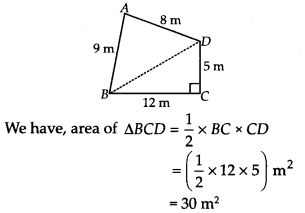
Now, to find the area of ∆ABD, we need the length of BD.
In right-angled ∆BCD, by Pythagoras theorem
BD2 = 502 + CD2
⇒ BD2 = 122 + 52
⇒ BD2 = 144 + 25 = 169
⇒ BD = 13 m
Now, for ∆ABD, we have
a = AB = 9 m, b = AD = 8 m, c = BD = 13 m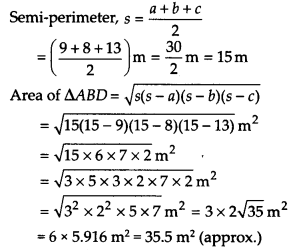
∴ Area of quadrilateral ABCD = area of ∆BCD + area of ∆ABD = 30 m2 + 35.5 m2
= 65.5 m2 (approx.)
Ex 12.2 Class 9 Maths Question 2.
Find the area of a quadrilateral ABCD in which AB = 3 cm, BC = 4 cm, CD = 4 cm, DA = 5 cm and AC = 5 cm.
Solution:
Given a quadrilateral ABCD with AB = 3 cm, BC = 4 cm, CD = 4 cm, DA = 5 cm and AC = 5 cm.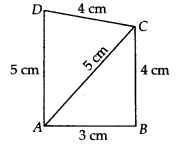
We are given a quadrilateral ABCD with the following side lengths:
- AB = 3 cm
- BC = 4 cm
- CD = 4 cm
- DA = 5 cm
- AC = 5 cm (diagonal)
To find the area of quadrilateral ABCD, we divide it into two triangles along diagonal AC:
- Triangle ABC
- Triangle ACD
We will find the area of both triangles using Heron’s formula and then add them.
Sides:
AB = 3 cm, BC = 4 cm, AC = 5 cm
First, calculate the semi-perimeter:
s₁ = (3 + 4 + 5) / 2 = 12 / 2 = 6 cm
Now apply Heron’s formula:
Area = √[s₁(s₁ – AB)(s₁ – BC)(s₁ – AC)]
= √[6 × (6 – 3) × (6 – 4) × (6 – 5)]
= √[6 × 3 × 2 × 1]
= √[36] = 6 cm²
Sides:
AD = 5 cm, CD = 4 cm, AC = 5 cm
Semi-perimeter:
s₂ = (5 + 4 + 5) / 2 = 14 / 2 = 7 cm
Now apply Heron’s formula:
Area = √[s₂(s₂ – AD)(s₂ – CD)(s₂ – AC)]
= √[7 × (7 – 5) × (7 – 4) × (7 – 5)]
= √[7 × 2 × 3 × 2]
= √[84] ≈ 9.17 cm²
Total Area = Area of triangle ABC + Area of triangle ACD
= 6 + 9.17 = 15.17 cm²
Question 3.
Radha made a picture of an aeroplane with coloured paper as shown in figure. Find the total area of the paper used.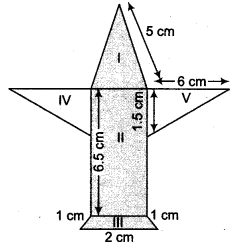
Solution:
For surface I:
It is an isosceles triangle whose sides are a = 5 cm, b = 5 cm, c = 1 cm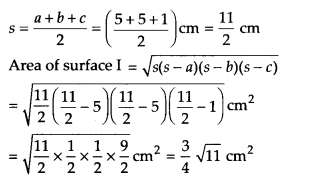
= (0.75 x 3.3) cm2
= 2.475 cm2 (approx.)
For surface II:
It is a rectangle with length 6.5 cm and breadth 1 cm.
∴ Area of surface II = Length x Breadth
= (6.5 x 1) cm2 = 6.5 cm2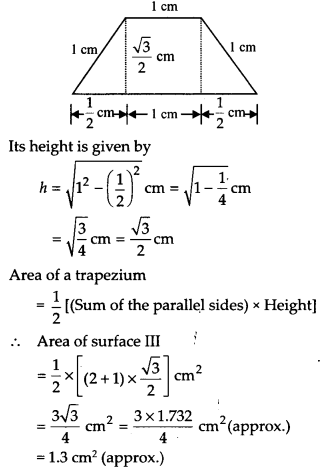
For surface III:
It is a trapezium whose parallel sides are 1 cm and 2 cm as shown in the figure given below: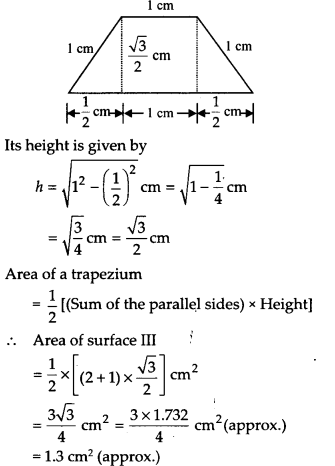
For surface IV and V:
Surface V is a right-angled triangle with base 6cm arid height 1.5 cm.
Also, area of surface IV = area of surface V
= 12 x base x height
= (12 x 6 x 15) cm2 = 4.5 cm2
Thus, the total area of the paper used = (area of surface I) + (area of surface II) + (area of surface III) + (area of surface IV) + (area of surface V) = [2.475 + 6.5 + 1.3 + 4.5 + 4.5] cm2
= 19.275 cm2
= 19.3 cm2 (approx.)
Question 4.
A triangle and a parallelogram have the same base and the same area. If the sides of the triangle are 26 cm, 28 cm and 30 cm, and the parallelogram stands on the base 28 cm, find the height of the parallelogram
Solution:
For the given triangle, we have a = 28 cm, b = 30 cm, c = 26 cm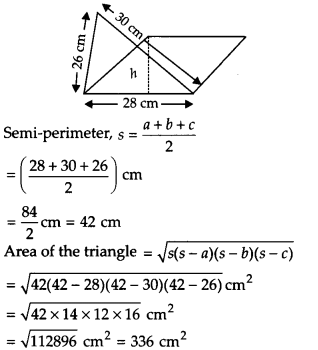
Area of the given parallelogram = Area of the given triangle
∴ Area of the parallelogram = 336 cm2
⇒ base x height = 336
⇒ 28 x h = 336, where ‘h’ be the height of the parallelogram.
⇒ h = 33628 = 12
Thus, the required height of the parallelogram = 12 cm
Ex 12.2 Class 9 Maths Question 5.
A rhombus shaped field has green grass for 18 cows to graze. If each side of the rhombus is 30 m and its longer diagonal is 48 m, how much area of grass field will each cow be getting?
Solution:
Here, each side of the rhombus = 30 m.
Let ABCD be the given rhombus and the diagonal, BD = 48 m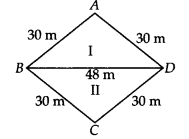
Sides ∆ABC are a = AB = 30m, b = AD = 30m, c = BD = 48m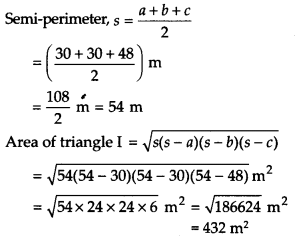
Since, a diagonal divides the rhombus into two congruent triangles.
∴ Area of triangle II = 432 m2
Now, total area of the rhombus = Area of triangle I + Area of triangle II
= 432 m2 + 432 m2= 864 m2
Area of grass for 18 cows to graze = 864 m2
⇒ Area of grass for 1 cow to graze = 86418 m2
= 48 m2
Ex 12.2 Class 9 Maths Question 6.
An umbrella is made by stitching 10 triangular pieces of cloth of two different colours (see figure), each piece measuring 20 cm, 50 cm and 50 cm. How much cloth of each colour is required for the umbrella?
Solution:
Let the sides of each triangular piece be
a = 20 cm, b = 50 cm, c = 50 cm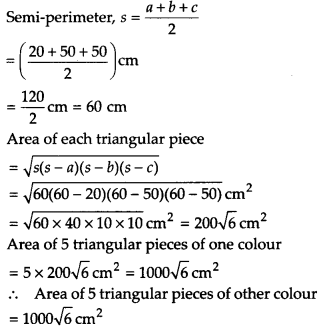
Ex 12.2 Class 9 Maths Question 7.
A kite in the shape of a square with a diagonal 32 cm and an isosceles triangle of base 8 cm and sides 6 cm each is to be made of three different shades as shown in figure. How much paper of each shade has been used in it?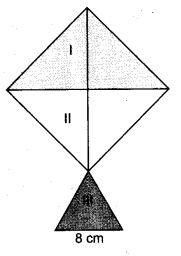
Solution:
Each shade of paper is divided into 3 triangles i.e., I, II, III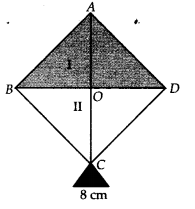
8 cm
For triangle I:
ABCD is a square [Given]
∵ Diagonals of a square are equal and bisect each other.
∴ AC = BD = 32 cm
Height of AABD = OA = (12 x 32 )cm
= 16 cm
Area of triangle I = (12 x 32 x 16 ) cm2
= 256cm2
For triangle II:
Since, diagonal of a square divides it into two congruent triangles.
So, area of triangle II = area of triangle I
∴ Area of triangle II = 256 cm2
For triangle III:
The sides are given as a = 8 cm, b = 6 cm and c = 6 cm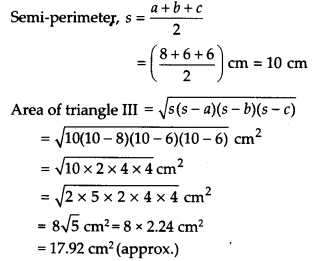
Thus, the area of different shades are:
Area of shade I = 256 cm2
Area of shade II = 256 cm2
and area of shade III = 17.92 cm2
Ex 12.2 Class 9 Maths
Question 8.
A floral design on a floor is made up of 16 tiles which are triangular, the sides of the triangle being 9 cm, 28 cm and 35 cm (see figure). Find the cost of polishing the tiles at the rate of 50 paise per cm .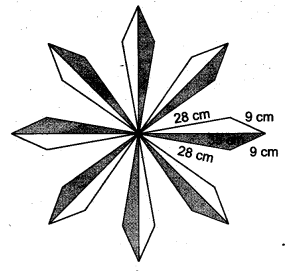
Solution:
Let the sides of the triangle be a = 9 cm, b = 28 cm, c = 35 cm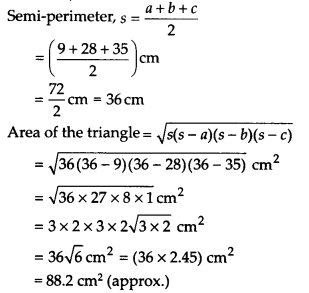
Total area of all the 16 triangles = (16 x 88.2) cm2 = 1411.2 cm2 (approx.)
Cost of polishing the tiles = Rs. 0.5 per cm2
∴ Cost of polishing all the tiles = Rs. (0.5 x 1411.2) = Rs. 705.60 (approx.)
Ex 12.2 Class 9 Maths
Question 9.
A field is in the shape of a trapezium whose parallel sides are 25 m and 10 m. The non-parallel sides are 14 m and 13 m. Find the area of the field.
Solution:
Let the given field is in the form of a trapezium ABCD such that parallel sides are AB = 10 m and DC = 25 m
Non-parallel sides are AD = 13 m and BC = 14 m.
We draw BE || AD, such that BE = 13 m.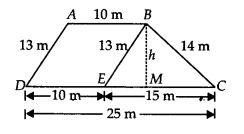
The given field is divided into two shapes (i) ∆BCE, (ii) parallelogram ABED For ∆BCE:
Sides of the triangle are a = 13 m, b = 14 m, c = 15 m
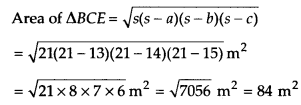
(ii) For parallelogram ABED:
Let the height of the ∆BCE corresponding to the side EC be h m.
Area of a triangle = 12 x base x height
∴ 12 x 15 x h = 84
⇒ (10 + 82×215 = 565
Now, area of a parallelogram = base x height
= (10 x 565) = (2 x 56) m2 = 112 m2
So, area of the field
= area of ∆BCE + area of parallelogram ABED
= 84 m2 + 112 m2 = 196 m2
The NEET Biology syllabus is primarily based on the NCERT Class 11 and 12 Biology textbooks, as prescribed by the National Testing Agency (NTA). For accurate and official study material, students are advised to refer to the NCERT e-books available on the official NCERT website.
